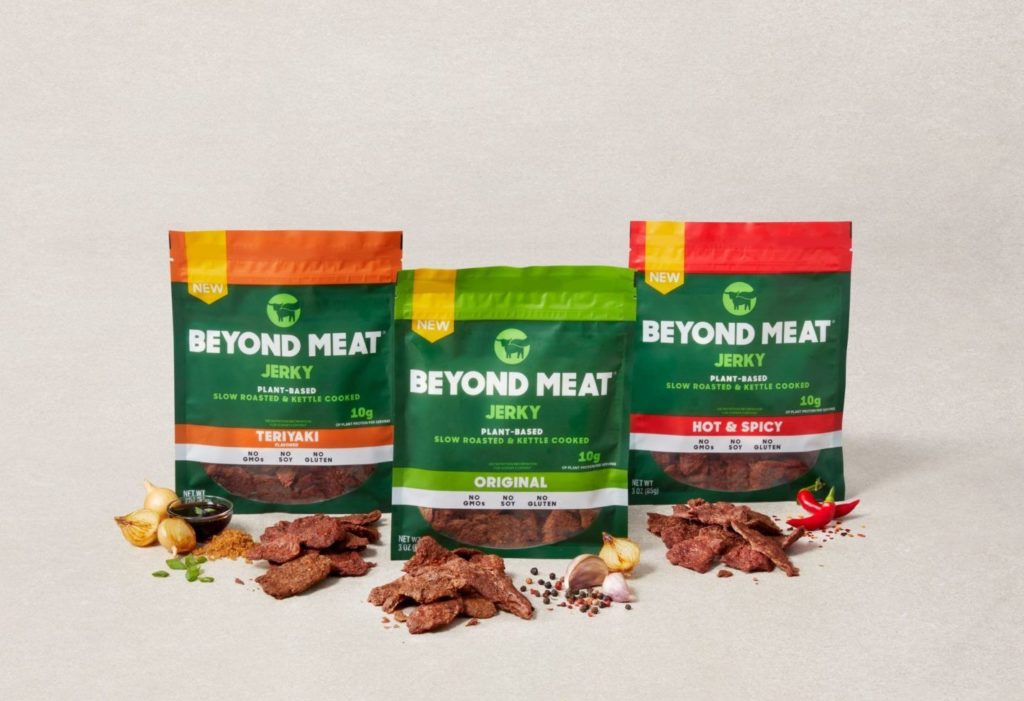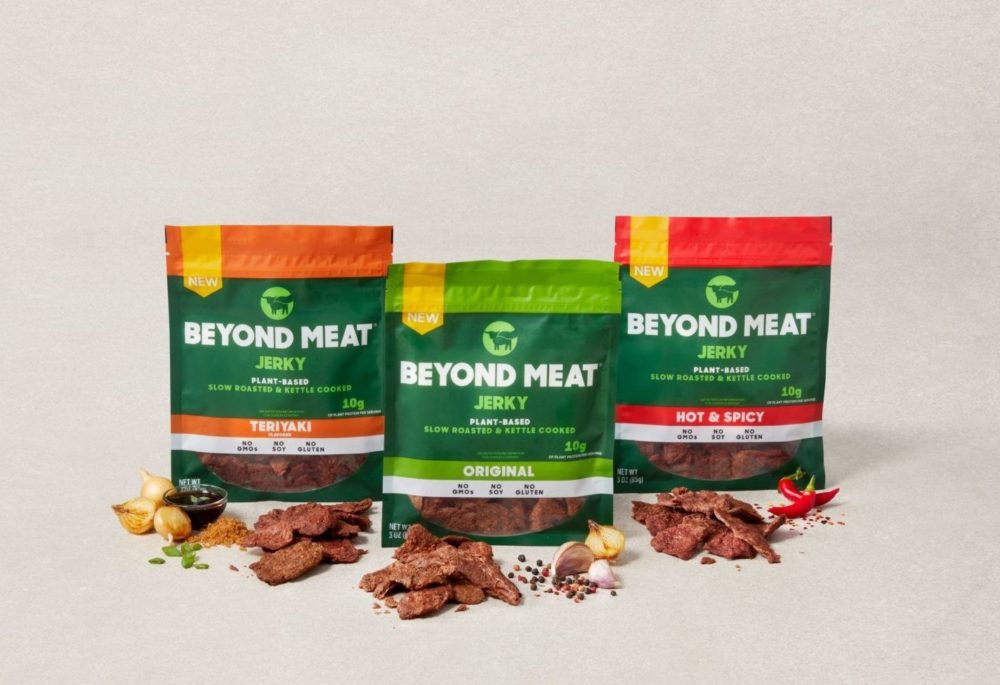Last week, a new product from Beyond Meat hit shelves in the US.
Beyond Jerky is — you guessed it — a plant-based analog of the much-beloved dehydrated, salted beef snack that comes in three flavors and, like its patty and sausage-link cousins, is made primarily from pea and mungbean protein.
It’s the first product to emerge from Planet Partnership, Beyond Meat’s joint venture with Pepsico, which they launched in January 2021 with the aim of “increasing accessibility to plant-based protein around the world” by creating “new snack and beverage options.”

As AFN reported at the time, Planet Partnership appeared to give Beyond Meat a channel for boosting its retail sales at a time when Covid-19 had severely hampered its foodservice business. The plant-based protein brand had reported a 41% decrease in restaurant sales in the last quarter of 2020.
But just over a year has passed since then; the market seems to be out of the Covid-19 woods – in North America, at least; and Beyond Meat’s most recent annual results, covering FY 2021, may give us more context around its push into snack sidelines like jerky.
‘Dampened’
Beyond Meat released its FY 2021 and Q4 2021 results last month, receiving a somewhat negative reaction from the market – with its share price tumbling as much as 15% in early trading the next day. Here are some of the headline figures for the three months ending December 2021:
- $100 million net revenues in Q4 2021 – down 1.2% year-on-year
- 14.1% gross margin ($14.2 million gross profit)
- $80.4 million net loss for Q4 – 79.8% of net revenues
- Adjusted EBITDA for the quarter was -$62.9 million, or -62.5% of net revenues
- US grocery sales down -20% in Q4
And for the full year:
- $465 million net revenues for FY 2021 – up 14.2% year-over-year
- 25.2% gross margin ($117 million gross profit)
- Net loss was $182.1 million; -39.2% of net revenues
- Adjusted EBITDA -$112.8 million, or -24.3% of net revenues
It tops off a fairly volatile two-and-a-half years for investors who bought Beyond shares at the company’s May 2019 IPO. In 2021, the company’s stock price fell by 71%.
Speaking on a conference call, Beyond Meat founder and CEO Ethan Brown said the 2021 results showed “sporadic yet promising signs” of a return to foodservice growth – but that this was “dampened by what we believe to be a temporary disruption in US retail growth, for our brand and the broader category.”
The problem with foodservice
Foodservice has proven important for Beyond Meat in terms of building recognition among consumers and notching up sales volumes. Over the past few years, the company has teamed up with the likes of KFC for Beyond Fried Chicken, McDonald’s for the McPlant burger, and Starbucks in China.
Writing in her Prime Future newsletter, Janette Barnard, associate director at Merck Animal Health Ventures, also noted that foodservice is Beyond’s best sales channel in terms of moving product; but she hypothesized that “much of the foodservice lift is from QSR chains […] trying to get a PR lift.”
“The canary in the coal mine is McDonald’s, and the test they are running with the [McPlant],” she said. “Menu board space is all the more precious now since the menu has been pared down to simplify operations and decrease wait times amid labor shortages. Amidst a pared-down menu board, sales have increased. Correlation or causation is hard to say, but it does seem reasonable to think that the hurdle to add something to the menu has been raised.”
“If McDonald’s rolls out plant-based burgers on a broad scale beyond the current trial, then my view might change,” Barnard added.
Early signs from the US market pilot aren’t entirely promising.
“Franchisee sentiment on the sales performance [of the McPlant has been] underwhelming […] Their assessment was that they don’t see enough evidence to support a national rollout in the near future and that lower sales volumes were slowing down service times, as the product was being cooked to order,” wrote Peter Saleh, analyst at BTIG Research & Strategy, in a note.
“We believe McDonald’s may continue to test and even offer McPlant in higher income, urban markets that appear more receptive to plant-based meat offerings, but a wide-scale launch seems a ways off at this point,” the note added.
Given this, retail is even more crucial for Beyond Meat’s future growth — and the long-term prospects for plant-based protein, in general — because of the potential it offers in terms of brand-building and higher profit margins, said Devi Subhakesan, co-founder at equities research firm Investory who publishes on Smartkarma.
“Retail sales are important for any consumer company that aspires to operate a high-margin business. Unless you have brand power and consumer acceptance, you have very little pricing power,” she told AFN.
“It may be easier to grow volumes in the foodservice sector, but it will always be a highly competitive segment in terms of pricing and margins. Moreover, unless you are a recognized and preferred brand, QSRs have no motivation to engage you.”
Growing competition
Beyond Meat is clearly making an effort to boost its retail presence – not least through less-obvious product lines such as Beyond Meat Jerky.
But as it tries to secure and expand its share of the plant-based protein market, it’s increasingly coming up against competition – and not just from its old archrival Impossible Foods.
“Plant-based meat is an increasingly crowded market, including private-label brands intent on competing on price, driving down margins of the whole category,” Barnard wrote. “If the growth rate is slowing, and more emerging brands are popping up, then suddenly the category is crowded and competing on price – and suddenly the whole category is much less interesting to [retail] investors.”
When Beyond Meat went public in 2017, it was one of only a handful of major players in the ‘new’ plant-based protein space. Since then, the number of startups — and corporates — offering plant-based analogs has exploded. Now there is a range of biomass fermented products to contend with as well; and cultivated meat may be inching closer to supermarket shelves, too.
These newer entrants are well funded; according to AgFunder‘s 2022 Agrifoodtech Investment Report, venture investment in Innovative Food — a category primarily consisting of alt-protein startups — more than doubled year-on-year, hitting $4.8 billion [disclosure: AgFunder is AFN‘s parent company.]
Impossible Foods, Nature’s Fynd, and NotCo were behind some of the category’s biggest rounds, each raising north of $200 million (Impossible was the only upstream startup to close a round of above $500 million in 2021.)
By comparison, Beyond Meat had raised a total of $122 million in venture funding prior to its IPO, according to Crunchbase.
Marketing spend swells
More competition means more spending on marketing, on hiring talent, and on tactical initiatives aimed at winning consumers.
“For now, leading incumbents — both Beyond Meat and Impossible Foods — are trying to defend market share through aggressive discounts and promotions,” Subhakesan said. “Beyond Meat’s FY 2021 revenue of $465 million — an increase of 14% year-on-year — was secured by spending nearly $100 million more [on sales, marketing, and general] expenses; that’s an increase of 57% year-on-year.”
The problem for Beyond Meat is that, even if the popularity of plant-based protein continues to grow and sales trend upwards, then much of that may be absorbed by its growing field of competitors — suggesting that there’s no clear end in sight for swollen marketing spend.
“The alternative protein space attracted undue attention and demand during the early Covid-19 period in 2020 when customers were wiping clean grocery shelves and were stocking up due to the prevailing uncertainty on supply. This was exacerbated in the US where there was a temporary supply shortage of animal products as many meat processing factories had to be shut down,” Subhakesan said.
“Beyond Meat reported its highest-ever sales growth back then. But this also attracted many players, including mainstream food processing companies, to enter this space rather quickly. So while demand normalized in 2021, supply multiplied and prices dropped. Abundant funding for new entrants and deep pockets of [established] food players means deep discounts and aggressive competition. This is both a short-term and long-term problem that Beyond Meat will have to face.”
A path to profitability?
Despite this, Beyond Meat is projecting net revenues of between $560 million to $620 million in 2022 – an increase of 21% to 33% on last year.
Subhakesan believes that, assuming the worst of the Covid-19 crisis is behind it, the company should experience a bounce in demand from the foodservice sector. Prior to the pandemic, it had reported $58 million in foodservice sales for Q4 2019, compared to the $36 million it made in Q4 2021.
Its expansion efforts in Europe and Asia Pacific, and further partnerships with other big brands, should also support revenue growth – if all goes according to plan.
But question marks remain over that all-important retail segment, where Beyond Meat Jerky may become a bellwether of things to come.
“In this context, management’s 20% to 30% growth guidance was below analyst expectations. The ‘unknown’ is the impact of competition, which is unlikely to abate soon,” Subhakesan said. “The food industry has realized that with greater awareness [around] climate change and the role played by the animal [agriculture] industry amongst the young generation, alternative protein demand is here to stay.”
Beyond Meat’s problematic performance in FY 2021 may impact the wider alt-protein industry in other ways, too – not least the prospects of further big-ticket IPOs in the space.
Archrival Impossible had reportedly been eyeing its own float by Q2 this year, but may be rethinking that timeline in light of Beyond’s battles.
“[Impossible] has raised more than $2 billion from private equity investors at equity valuations north of $5 billion, with hopes of going public at a $10 billion valuation,” Subhakesan said. “With Beyond‘s market cap at less than $3 billion, the prospect of an IPO in the sector seems tough in the near term.”




